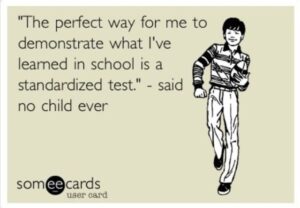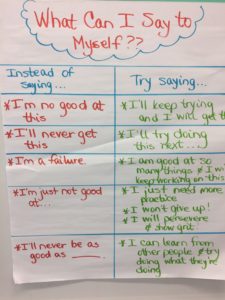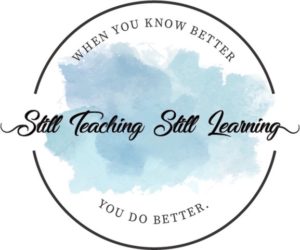
“End of year testing is my favorite time of year!” said no teacher ever. (No student ever either.)
Unfortunately, the tests are here to stay. Teachers know that part of our job is to help our students be as well prepared for the tests as possible.
How do we do that? How do we do that? Here are some tips I’ve collected over the years for preparing your students while keeping the test prep as engaging as possible.

PLAN YOUR TESTING REVIEW STRATEGY
The first step is to make a plan for test review. Block out time for some practice before state testing begins. This doesn’t need to take hours or several weeks. Two weeks is usually ample time. It also doesn’t need to take up all day, every day. It’s better to do little bits every day rather than big “cram” sessions, which tend to burn kids out and cause anxiety.
As much as possible, show students what test questions will look like and discuss what the questions ask them to do.

Here’s how to do that.
~Find your state’s released versions of tests. They are usually posted on your state’s Department of Education website. These items are best for showing your students exactly what your state’s test questions will look like.
~It can also be helpful to use other states’ released test items so that your students see various problems and questions. Tammy from Tarheelstate Teacher has some good suggestions HERE. (She also has a great resource for reading tests on Teachers Pay Teachers.)
~Try taking the test yourself! What do YOU do to help yourself solve the problems or read the passages and answer questions? What tips helped you? Show your students your own thought process!

~Pay attention to the vocabulary of test questions. I find that this is what trips students up the most. Phrases like “draw a conclusion,” “according to the text . . . .,” and “what can you infer? “ are not typical phrases we use when we talk to students.
One way to “teach” this vocabulary is to create a T-chart of these words and phrases from sample test questions. List the words and phrases on the left, then have students help you interpret what those words and phrases mean on the right side.

MAKING PRACTICE MORE FUN & ENGAGING
Above all, try to keep your test review practice as fun and engaging as possible. Here are some ways to do that.
~Use non-permanent vertical surfaces (like THESE, but you could also use chart paper) and have students work in groups of three or four.
Attach a math problem, science question, or reading passage to the top of the whiteboard or chart. Allow students to collaborate to answer the question and show their work, as needed.
Circulate to check their work. When everyone has completed their task, have them rotate to the next whiteboard or chart paper and work on the next task.

~Use game sites such as Kahoot, Quizizz, Quizlet (great for vocabulary), Blooket, or Gimkit.
~Create a Jeopardy game to review content, using an online Jeopardy template like this one.
~Use some of your state’s reading question stems and write them on different sections of an inexpensive beach ball.
Read a short passage as a class, then toss the beach ball to a student. They answer the question closest to their right thumb (getting help from classmates as needed), then they toss it to another student to answer a different question.

~Divide students into teams and distribute small whiteboards. Post a question from your state’s math or science test and allow students to use their whiteboards to write their answers. (They can collaborate as needed.) Have the whole team show their whiteboards, or you could rotate and choose different students. Teams earn a point for every correct answer.
~Play “Prove It” with reading tests. Allow time for everyone to read the passage and the questions, but hide the answer choices. Call on a student to answer a question. The rest of the class gets to call out, “prove it!” The student then explains how they figured out the answer.
After they answer the question, display the answer choices and have the student (or the class) choose the answer choice that most closely matches the student’s correct answer. (This is great for teaching students to think about what they think the answer is, before reading the answer choices.)

~Play “Headbands” with concepts or vocabulary. Put students in small groups of three or four. Give the student guesser an index card with a concept or vocabulary word written, but they should not look at it.
The student who will be guessing then holds the card up on their forehead. The other group members give the guessing student clues so they can figure out the concept or word.
Then, the guessing turn passes to another student.
~Play “Four Corners” with multiple choice answers. This works better for science or other content area questions.
Display the question and answer choices. Give students time to think about their answer. Then announce choice A’s corner, choice B’s corner, etc. and allow students to move to their answer choice.
Discuss the correct answer and why it is one choice and not another.

REVIEWING CONTENT FOR TESTS
~Allow students to work together to create a class anchor chart to teach/review a math or science concept.
Hopefully, you have used anchor charts all year long. Remind your students to refer to them often! Even though you have to remove them before the test, students will remember most of what was on the chart when they look at that wall area.
~For math questions, remind students to visualize what the question is asking them to do.
Here is a strategy I recently learned, which works very well.
Retell the problem in your own words.
Read #1: what is the story?
Read #2: what are the quantities?
Read #3: what is the question?
Represent the problem with pictures or equations.
Reason – does your answer make sense? (Remind student to double-check multiplication facts, addition and subtraction.)

~A great retrieval practice strategy is a “brain dump.”
Here’s how to do that:
*List the topic on the board and set a timer for 2-3 minutes.
*Have students write down everything that they can remember about the topic (or about how to solve the math problem).
*Another option is to ask them to write 1-3 things they can remember, and NOT set a time limit.
*Then let students turn & talk with a partner or table group and share what they remember.
By the way, this is a fun and engaging strategy to use for review and practice throughout the year, not just when preparing for end of year tests.

~Provide lots of opportunities to study vocabulary terms for science or math tests. The game sites linked above are great for this practice.
~Mix up the math problems – addition, subtraction, multiplication, and division problems. The tests never have all of one topic together, so we need to help students practice “switching” between different math topics.
~Use the 50-50 strategy by trying to eliminate two answer choices that cannot possibly be correct. Some teachers call this strategy “slash the trash.”
~Remind students that they HAVE to look back in the text to answer the questions. This applies to all questions, but especially to questions that ask what a word means in THIS passage. (The words chosen for tests are typically words that have multiple meanings, so students need to reread to be sure their answer choice is correct.)

MAINTAINING STAMINA
Stamina is one of the most important factors in test-taking. These standardized tests usually take about two hours. That is a long time to maintain focus and stare at a screen.
The best preparation is building up stamina throughout the year (during independent reading, for example).
You can challenge your students to work on their stamina as part of their test prep practice. Then, have them share their strategies for getting back on track if they find their energy waning and their minds wandering.

Here are some student-suggested strategies for maintaining stamina and taking “brain breaks” during testing:
*look away from the screen for a few seconds
*close your eyes for a few seconds
*massage your temples
*take quiet deep breaths – in through the nose, out through the mouth
*rotate your neck in circles
*stretch your shoulders or stretch your legs

TEST-TAKING STRATEGIES
Teach your students test-taking strategies and have them practice the strategies as they take practice tests or work on practice problems.
READING TEST STRATEGIES
~Try using the SMART strategy:
S – scan title and passage
M – make manageable parts to read (choose a “chunk” of the text to read, then stop and think about what’s happening in the text)
A – add notes as you read
R – return to the passage for evidence
T – try out all answers to find the best one

~Tell students to LOVE the selection! Have them practice saying things like “I’ve always wanted to read about . . .” or “Yay! I get to read . . . “ Tell yourself that you’re excited to read this passage. (And you only have to love it for 15-20 minutes.)
This is a much better option than looking at a passage and thinking that it looks hard or boring. When we approach something with excitement (even if it’s fake), we read it differently.

~Read the question, but think about what YOU think the answer might be before you read the answer choices. (This is similar to solving the math problem before looking at the multiple-choice answers.)
~Look back in the text, especially for the vocabulary questions.

STRATEGIES FOR ALL TESTS
~Read all of the answer choices before making a selection.
~Use the 50-50 strategy. Try to eliminate two answers that couldn’t possibly be correct.
~Flag a question and come back to it later if you’re having trouble with it.

~Solve the problems on the math test! Don’t just guess an answer choice that looks like it could be right
~Teach your students to take their own brain breaks during the test when their attention is wandering (see the suggestions in the “Stamina” section).

SUPPORT
~Show students what to do with the blank paper provided for the test. Do you expect them to use it for solving math problems, listing vocabulary terms for content, or taking notes on a reading passage? Show them what you expect and incorporate that into your test prep practice.
~Another option for the blank paper is for students to write down affirmations or “sunny thoughts” that encourage them. You might make a list of these prior to testing days and tell students to choose the ones that resonate most with them. They can write them on their blank paper. Seeing that encouragement during testing might help them keep going!

Suggestions for a “sunny thoughts” poster:
I can do this!
I won’t give up, even if something is hard!
I will relax and use my strategies!
When my brain gets tired, I will take a break so I can re-focus!
I believe in myself!
I will do my best, no matter what!
~Show students any tools they may use on the test. For example, our state’s online test includes a highlighter tool and a tool for slashing the wrong answers. Show students how to use these tools.

~Ask families to write a letter to their students, encouraging them to do their best on the test and reassuring them of their love and belief in the student. These letters can be opened on the morning of the test. (My students have always loved receiving these.) Let families know about this and ask for the letters to be returned to you by 1-2 weeks before the test. If a family does not return a letter, this gives you time to find a special adult within the school who will write a letter to the student.
~Finally – plan some fun, hands-on activities after testing is over the day. Extra recess is an obvious choice, but think of some other classroom projects that might be fun to do during that time. Here is another post with some ideas!

No one likes standardized testing, but we all understand the purpose that it serves. Helping our students to be prepared and confident is our goal. I hope some of these tips will be helpful to you and your students! The best news about the testing season is that summer is not far away!
